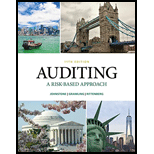
a.
Introduction: Sampling is the technique of selecting a smaller portion for a large population for the purpose of statistical analysis or research. There are various methods of selecting a sample depend upon the type of analysis or research.
The sample size.
b.
Introduction: Sampling is the technique of selecting a smaller portion for a large population for the purpose of statistical analysis or research. There are various methods of selecting a sample depend upon the type of analysis or research.
To calculate: The type of opinion given to the client internal controls.
c.
Introduction: Sampling is the technique of selecting a smaller portion for a large population for the purpose of statistical analysis or research. There are various methods of selecting a sample depend upon the type of analysis or research.
The potential misstatement from the control deviation.
d.
Introduction: Sampling is the technique of selecting a smaller portion for a large population for the purpose of statistical analysis or research. There are various methods of selecting a sample depend upon the type of analysis or research.
The substantive
Trending nowThis is a popular solution!

Chapter 8 Solutions
Auditing: A Risk Based-Approach (MindTap Course List)
- Attribute sampling enables the auditor to directly assess whether a rule is operating successfully or not, sampling is more reliable for assessing controls. This is crucial in circumstances where data accuracy or completeness are essential, such as when a credit-check control is used for consumer orders. The focus is on estimating the overall monetary value of a population, therefore monetary-unit sampling is more suitable for verifying the accuracy of financial statements or specific account balances. It is crucial to remember that the exact audit objectives and the type of data being checked will determine the sampling technique that is used. Do you believe monteray unit sampling can do the same thing?arrow_forwardIn an audit sampling application, an auditora. Performs procedures on all items in a balance and makes a conclusion about the entirebalance.b. Performs procedures on less than 100 percent of the items in a balance and formulates aconclusion about the entire balance.c. Performs procedures on less than 100 percent of the items in a class of transactions tobecome familiar with the client’s accounting system.d. Performs analytical procedures on the client’s unaudited financial statements when planning the audit.arrow_forwardFrancona Madden, an audit manager, considered the control risk assessments listed in theleft column of the following table in evaluating A. Cardinal’s internal control over salestransactions. The sample sizes for the substantive procedures of the customer accountsreceivable are shown to the right of each control risk. What risk of overreliance (ROO)could be assigned for tests of controls at each control risk level? Control Risk Accounts Receivable Sample ROO 0.20 400 ? 0.50 390 ? 0.80 350 ? 0.90 190 10% a. From top to bottom: 5 percent, 10 percent, 1 percent.b. From top to bottom: 10 percent, 1 percent, 5 percent.c. From top to bottom: 1 percent, 10 percent, 5 percent.d. From top to bottom: 1 percent, 5 percent, 10 percent.arrow_forward
- Jerry Tim is examining an important internal control in the audit of Langly Company. Inpast audits, deviations from this control have been observed at a minimal rate (less than 0.1percent); however, because the account balance affected by this control is highly susceptibleto fraud, it is important that Tim obtain a high level of assurance that deviations occur at nohigher than a predetermined (low) rate. Which of the following sampling methods wouldTim most likely use to evaluate this control?a. Attributes sampling.b. Discovery samplingarrow_forwardJerry Tim is examining an important internal control in the audit of Langly Company. Inpast audits, deviations from this control have been observed at a minimal rate (less than 0.1percent); however, because the account balance affected by this control is highly susceptibleto fraud, it is important that Tim obtain a high level of assurance that deviations occur at nohigher than a predetermined (low) rate. Which of the following sampling methods wouldTim most likely use to evaluate this control?a. Attributes sampling.b. Discovery sampling c. Sequential sampling.d. Statistical sampling.arrow_forward
 Auditing: A Risk Based-Approach (MindTap Course L...AccountingISBN:9781337619455Author:Karla M Johnstone, Audrey A. Gramling, Larry E. RittenbergPublisher:Cengage Learning
Auditing: A Risk Based-Approach (MindTap Course L...AccountingISBN:9781337619455Author:Karla M Johnstone, Audrey A. Gramling, Larry E. RittenbergPublisher:Cengage Learning Auditing: A Risk Based-Approach to Conducting a Q...AccountingISBN:9781305080577Author:Karla M Johnstone, Audrey A. Gramling, Larry E. RittenbergPublisher:South-Western College Pub
Auditing: A Risk Based-Approach to Conducting a Q...AccountingISBN:9781305080577Author:Karla M Johnstone, Audrey A. Gramling, Larry E. RittenbergPublisher:South-Western College Pub


